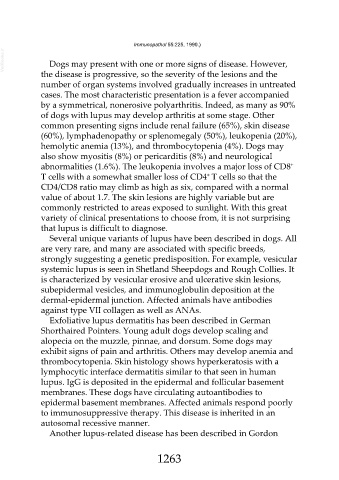Page 1263 - Veterinary Immunology, 10th Edition
P. 1263
Immunopathol 55:225, 1990.)
VetBooks.ir Dogs may present with one or more signs of disease. However,
the disease is progressive, so the severity of the lesions and the
number of organ systems involved gradually increases in untreated
cases. The most characteristic presentation is a fever accompanied
by a symmetrical, nonerosive polyarthritis. Indeed, as many as 90%
of dogs with lupus may develop arthritis at some stage. Other
common presenting signs include renal failure (65%), skin disease
(60%), lymphadenopathy or splenomegaly (50%), leukopenia (20%),
hemolytic anemia (13%), and thrombocytopenia (4%). Dogs may
also show myositis (8%) or pericarditis (8%) and neurological
abnormalities (1.6%). The leukopenia involves a major loss of CD8 +
+
T cells with a somewhat smaller loss of CD4 T cells so that the
CD4/CD8 ratio may climb as high as six, compared with a normal
value of about 1.7. The skin lesions are highly variable but are
commonly restricted to areas exposed to sunlight. With this great
variety of clinical presentations to choose from, it is not surprising
that lupus is difficult to diagnose.
Several unique variants of lupus have been described in dogs. All
are very rare, and many are associated with specific breeds,
strongly suggesting a genetic predisposition. For example, vesicular
systemic lupus is seen in Shetland Sheepdogs and Rough Collies. It
is characterized by vesicular erosive and ulcerative skin lesions,
subepidermal vesicles, and immunoglobulin deposition at the
dermal-epidermal junction. Affected animals have antibodies
against type VII collagen as well as ANAs.
Exfoliative lupus dermatitis has been described in German
Shorthaired Pointers. Young adult dogs develop scaling and
alopecia on the muzzle, pinnae, and dorsum. Some dogs may
exhibit signs of pain and arthritis. Others may develop anemia and
thrombocytopenia. Skin histology shows hyperkeratosis with a
lymphocytic interface dermatitis similar to that seen in human
lupus. IgG is deposited in the epidermal and follicular basement
membranes. These dogs have circulating autoantibodies to
epidermal basement membranes. Affected animals respond poorly
to immunosuppressive therapy. This disease is inherited in an
autosomal recessive manner.
Another lupus-related disease has been described in Gordon
1263

